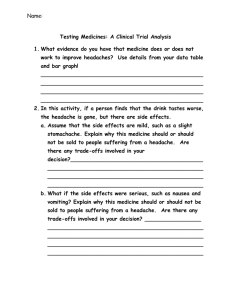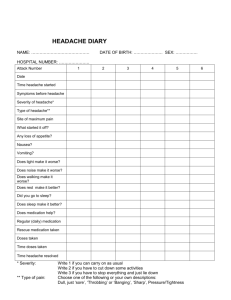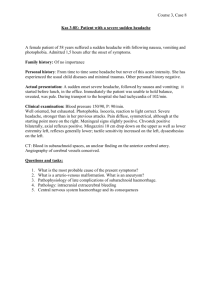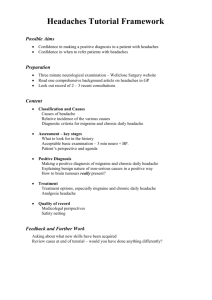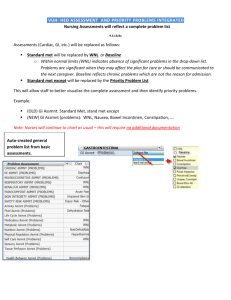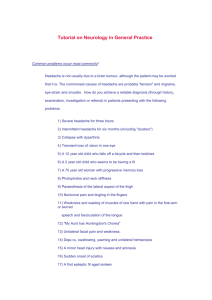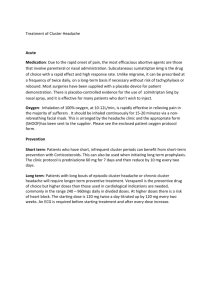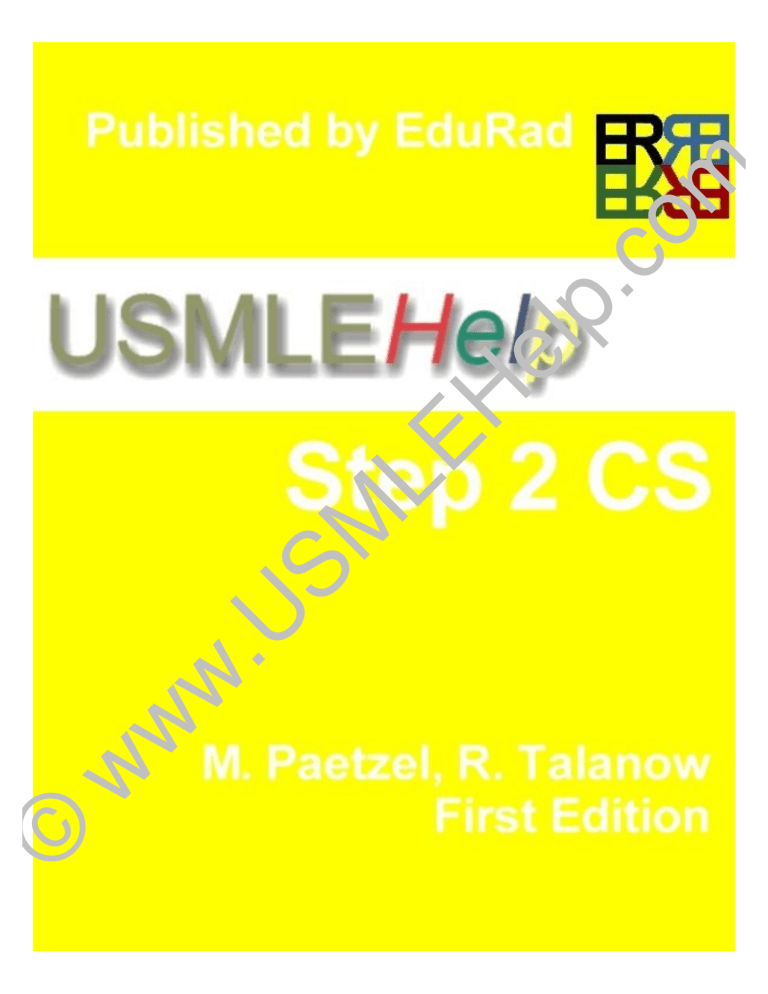
©
w
w
w
.U
SM
LE
H
el
p.
co
m
USMLEHelp Step 2 CS
LE
H
el
p.
co
m
Authors:
Martina Paetzel, M.D.
Roland Talanow, M.D., PhD.
Notice: The authors of this volume have taken care to ensure that doses
of certain drugs are correct & compatible with today’s medical standards.
However, as new information becomes available, changes in treatment &
in the use of drugs becomes necessary. The authors & publisher
disclaim all responsibility for any liability, loss, injury or damage incurred
as a result, directly or indirectly, of the use & application of any of the
contents in this published work.
All rights reserved. This book, or any parts thereof, may not be used or
reproduced in any manner without written permission of the authors &
publisher.
Please visit them on the web for more information.
www.EduRad.org & www.USMLEHelp.com
.U
SM
Disclaimer: USMLEHelp is in accordance with the United States Medical
Licenscing Examination (USMLE) in that it does not reproduce any
unauthorized data, including reconstruction through memorization, &/or
dissemination of copyrighted examination materials by any means. They
do not provide or attempt to provide any information, including that
relating to examination content or answers ,that may give or attempt to
give unfair advantage to individuals who may be taking the examination.
©
w
w
w
None of the cases listed here are from actual exams – USMLEHelp has
constructed them & tested them on their surveyed students, who have
given their experiences about their USMLEHelp testing process. Any
“experience note” is the experience of our testing protocol, not that of the
USMLE organization.
Copyright © 2006 by EduRad.org
PRINTED IN THE UNITED STATES OF AMERICA
LE
H
el
p.
co
m
Welcome to the USMLEHelp Step 2 CS review book. We are sure you
will benefit & find this book helpful for you when you study for the Step 2
CS. This exam is marked “easy” by many, however if you are not familiar
with Americanisms, it might not be that “easy” for you. We have tried to
gear this book for both Americans & foreigners to the country.
This exam is testing your ability to communicate with patients, but also
your ability to take a good health history, to sum up the patient’s
complaints, & to report them so that everyone can understand what’s
going on with the patient.
We occasionally talk about our surveyed students. You will see what
they have to say in our
Experience Notes
.U
SM
under various sections.
We asked 43 students who took the
USMLEHelp Step 2CS simulated examination about their experiences.
38 of them passed the first time around, & 5 of them did not, but those
passed on the second try. Our students were foreign IMGs, American
graduates, & American IMGs. So, we’ve covered many topics that are
beneficial to everyone.
©
w
w
w
Our book tells you about the exam right at the beginning, so that you
know what is high-yield. We want you to be familiar with the test-setup,
& not wait until the end of the book to know what you’re up against.
Furthermore, we have listed the “reasons for failure” at the beginning as
well, not to scare you, but rather to help guide you in doing things
correctly.
We wish you the best of luck for the Step 2 CS examination, & would
love to hear your experiences! Please visit us on the web at
http://www.usmlehelp.com!
©
w
w
w
.U
SM
LE
H
el
p.
co
m
LE
H
el
p.
co
m
Patient note
History – Include significant positive & negatives from history of present illness, past medical
history, review of systems, social history & family history
L
I
Q
Write your LIQORAAA & PAM
HUGS FOSS on your scratch
paper outside the door, so when
you go in the room to see your
patient, you won’t forget to ask
those questions!
O
R
A
A
A
P
SM
A
M
H
.U
U
S
©
w
w
F
w
G
O
S
S
©
w
w
w
.U
SM
LE
H
el
p.
co
m
Case: 17 year-old male patient with headache
CC: Gary is a 17 yo w. male patient stating he has a headache.
HPI: This male reports that he was well until 3 days prior when he started to
develop an intermittent bilateral headache located frontally, but that radiates
to the occipital region. He has no signs of aura, & the headache is constant,
without pulsation. He wants to participate in the next football game because
he is the captain of the football team.
FH: Both parents are healthy. His maternal grandfather died of an MI.
PMH: No previous illnesses. Immunizations are up-to-date. No Hx of
recent trauma.
SH: Lives at home with his parents. He does not smoke, no alcohol intake or
other drugs.
ROS: Unremarkable
Physical Examination
General: Patient is not in distress, & appears well. Vital signs: HR:
85/min, T: 37*C, R: 12/min, BP: 125/80
HEENT: Conjunctivae & pupillary reflexes normal. ENT was WNL.
Palpation of the neck muscles caused localized pain & tenderness that radiated
to the occipital region.
Chest: No wheezing, crackles & breath sounds were normal. Normal heart
sounds & rhythm, no evidence of murmurs or rubs. Normal S1, S2.
Abdomen: Normal on inspection, soft without tenderness. Bowel sounds
normal.
Neuro: Alert, well-oriented x 3. Cranial nerves WNL. Motor 5/5.
DTRs were WNL.
DD:
Diagnostic Workup Plan
1. Tension Headache
1. CBC
2. Electrolytes
2.Migraine Headache
3. Cluster Headache
3. Cranial x-ray
4. Sinus infection with headache
4. ESR
5. Nasal polyp
To most, this note is not that legible.
Perhaps you should try reading it again in better handwriting:
LE
H
el
p.
co
m
Here are some questions you might want to ask this
alcoholic patient:
©
w
w
w
.U
SM
1. Do you consume alcohol? If so, how much & how
often do you drink? If occasional, ask what they
mean by that.
2. Ask if they've ever felt the need to cut down, feel
annoyed by the criticism about their drinking, feel
guilty about drinking, or ever need a drink in the
morning to get rid of a hangover (eyeopener)?
3. You should ask about support systems, stresses,
anxieties which may be leading to the problem
4. Be sure to ask about any symptoms of alcoholic
liver disease, any hematemasis, ulcer pain, wasting,
gynaecomastia, pigmentations on chest/hands
5. Ask the patient about how alcohol is affecting their
relationships at work, with their spouse & kids?
6. Ask if there are any problems with fertility?
7. The most important step is to counsel this patient.:
talk about Alcoholic's anonymous, & Al-non, talk
about providing support, Disulfiram/Naltrexone (or
“that there are drugs that can help you overcome
the initial difficulties:”)
LE
H
el
p.
co
m
Common Questions
©
w
w
w
.U
SM
When do we drape?
The answer to this question depends mainly on your personality.
Some guides will tell you to do this right away, whereas others
might leave it open. We feel the best way to know when to do it
is by asking the patient! “Would you feel more comfortable with
the blanket?” (as you reach for the blanket). Or “Are you cold?
Would you like to cover up a little? I know how air conditioning
can be – I’ve got so many more layers on than you!”
LE
H
el
p.
co
m
Case#. CC: Mr. Rudolph is here for a stuffy nose
Vitals: BP 120/80, Pulse 95, RR 14, Temp 98° F
(36.7° C)
Age: 55 year old male Asian
©
w
w
w
.U
SM
What are your
differential diagnoses?
Tasks:
1. Take a focused history.
2. Perform a focused physical exam (no rectal, genitourinary or
female breast exams)
3. Explain your clinical impression & further plans to the patient.
4. Write the patient note after leaving the examining room.
LE
H
el
p.
co
m
HPI: This patient comes to the office with complaints of a stuffy
nose. It started abruptly after he had a late night snack. He
has been having this pain (but not as bad as this) for the last 3
weeks.
PMH: He had a stuffy nose as a child
FH: Her father had a stomach ulcer when she was still in
school. He has 3 healthy children.
SH: He is a postal worker for over 20 years. Married, nonsmoker. Drinks alcohol on the weekens.
SM
PSH: Not significant
©
w
w
w
.U
When the doctor palpates
your face, please say
“ow!”
LE
H
el
p.
co
m
PE: General appearance: the patient is a well-nourished ale
who appears pale & ill. He has a reddened nose.
HEENT/Neck: Reddened nose, obvious excoriations,
presumably from tissue paper.
Increased mucous,
erythematous mucous membranes.
Chest/lungs: Some wheezing noted,
Heart/CV: WNL,
Abdomen: WNL,
Extremities: WNL,
Neuro/Psych: WNL
Diagnostic Workup: EGD, EKG, CBC with differential, BMP,
Counsel: Educate family, educate patient, reassurance
.U
SM
DD: Viral infection, sinusitis, Wegener’s disease, bacterial
infection.
©
w
w
w
Did you ask if your workup plan was
agreeable to the patient?
LE
H
el
p.
co
m
Complete Patient note for every case! Over 40 cases!
Case: 17 year-old male patient with headache
©
w
w
w
.U
SM
CC: Gary is a 17 yo w. male patient stating he has a headache.
HPI: This male reports that he was well until 3 days prior when he
started to develop an intermittent bilateral headache located frontally,
but that radiates to the occipital region. He has no signs of aura, & the
headache is constant, without pulsation. He wants to participate in the
next football game because he is the captain of the football team.
FH: Both parents are healthy. His maternal grandfather died of an MI.
PMH: No previous illnesses. Immunizations are up-to-date. No Hx of
recent trauma.
SH: Lives at home with his parents. He does not smoke, no alcohol
intake or other drugs.
ROS: Unremarkable
Physical Examination
General: Patient is not in distress, & appears well. Vital signs: HR:
85/min, T: 37*C, R: 12/min, BP: 125/80
HEENT: Conjunctivae & pupillary reflexes normal. ENT was WNL.
Palpation of the neck muscles caused localized pain & tenderness that
radiated to the occipital region.
Chest: No wheezing, crackles & breath sounds were normal. Normal
heart sounds & rhythm, no evidence of murmurs or rubs. Normal S1,
S2.
Abdomen: Normal on inspection, soft without tenderness. Bowel
sounds normal.
Neuro: Alert, well-oriented x 3. Cranial nerves WNL. Motor 5/5. DTRs
were WNL.
DD:
Diagnostic Workup Plan
1. Tension Headache
1. CBC
2. Migraine Headache
2. Electrolytes
3. Cluster Headache
3. Cranial x-ray
4. Sinus
infection
with
4. ESR
headache
5. Nasal polyp
LE
H
el
p.
co
m
Abbreviations
We know that most of you are struggling with the language, & you’re
probably worried about how you are going to write everything so quickly.
We have listed the most common abbreviations you will need for your
exam here, in alphabetical order, so you can quickly reference them.
This is not a complete list, but this will help you write your note much
quicker for the exam.
Again, if you practice using these abbreviations, they will soon become
part of your method. Without practicing, these might not be helpful to
you, yet harmful. If you do not feel comfortable using abbreviations, do
not use them. Write the word fully then. No uncommon abbreviations
will be accepted at the USMLE exam. Use only abbreviations that are
commonly used in the United States.
SM
This might not be a complete list, so please refer to your USMLE hand
guide for more.
-
w
AA
alc.
AXR
b.i.d.
BP
BUN
C
CBC
CBC w/diff
w
w
©
And
Number
per (i.e. 3 glasses wine/day)
Positive
Times (Oriented x 3, i.e. oriented to time, self,
place)
African American
Alcohol
Abdominal X-ray
Twice a day
Blood pressure
Blood urea nitrogen
Celsius
Complete Blood Count
Complete Blood Count with Differential
.U
+, &
#
/
+
x
-
LE
H
el
p.
co
m
Other products we offer:
USMLEHelp Step 2 CK
USMLEHelp Step 2 CS Online
©
w
w
w
.U
SM
Visit us on the web today!
http://www.usmlehelp.com
Join our discussion forum!
http://www.usmleforums.net

